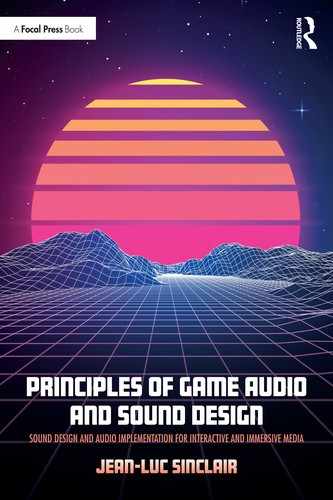DETAILED CONTENTS
1 The Genesis of Audio in Games
2 From Sample Playback to Procedural Audio
2 The Role of Audio in Interactive and Immersive Environments
a Geometry/Environment: Spatial Awareness
d User Feedback and Game Mechanics
2 Repetition and Fatigue Avoidance
3 Interactive Elements and Prototyping
5 Environmental Sound Design and Modeling
7 Asset Management and Organization
a 2D, 3D and Cartesian Coordinates
Rigidbodies and Collision Detection
4 The Audio Engine and Spatial Audio
1 Listeners, Audio Clips and Audio Sources
3 Attenuation Shapes and Distance
b Sound Cones – Directional Audio Sources
4 Features of Unity’s Audio Engine
2 Audio Localization and Distance Cues
b Dry to Reflected Sound Ratio
c Low Pass Filtering With Distance
a Localization on the Horizontal Plane
b Localization on the Vertical Plane
a Object-based Audio and Binaural Renderings
c Multichannel Audio and Ambisonics
4 Optimizing Sound Design for Spatialization
b Working With 2D and Multichannel Audio
d Working With Object-Based Audio
5 Sound Design – The Art of Effectively Communicating With Sound
1 A Brief History of Sound Design
2 Sound Design – Basic Considerations
a Microphone Choice: Dynamic vs. Condensers
5 Sound Design – Before You Start
a Always Use High Quality Material
d Listen for the Expected and the Unexpected
h Experiment, Experiment, Experiment
c Fast Fourier Transform-Based Algorithms
a Blending Through Bus Compression
a Equalization for Sound Design
6 Harmonic Generators/Aural Exciters
7 Granular Synthesis and Granulation of Sampled Sounds
a Granular Synthesis Terminology
b Sound Design Applications of Granular Synthesis
a Ring Modulation/Amplitude Modulation
c Reverberation for Environmental Modeling
d Reverberation as a Dramatic Tool
b Speaker and Electronic Circuit Emulation
c Filtering/Very Small Space Emulation
1 Setting Up a Sound Design Session and Signal Flow
e Metering: Pre-Fader vs. Post Fader
3 Clipping Is Easy – Mind the Signal Path
4 Setting Up a Basic Session for Linear Mixes and Cut Scenes
a Music, Dialog and Sound Effects
b Inserts vs. Effects Loops for Reverberation
2 Practical Sound Design and Prototyping
c Processing and Preparing Your Material
a Primary vs. Secondary Sounds
c Working With Vocal Recordings
e Working With Non-Human or Animal Samples
4 An Adaptive Crowd Engine Prototype in MaxMSP
3 Basic Object-Oriented Programming Concepts
a Procedural vs. Object-Oriented
b Encapsulation and Inheritance
2 An Intro to C#: Syntax and Basics
2 Variables, Constants, Data Types Operators, Arrays and Lists
3 Accessing a Function From Another Class
a Timing – Frame Rate vs. Absolute Time
b Linear vs. Logarithmic Amplitude
8 Implementing Audio: Common Scenarios
1 Before You Start: Preparing Your Assets
1 Creating Ambiences and Loops
b Creating a Simple Loop – Looping Techniques
2 Implementing Our Loops in a Unity Level
c Working With the Time Property to Avoid Phasing Issues
a A Simple Random Emitter Algorithm
4 Ambiences, Putting It All Together
a Creating Variations With Footsteps Samples
b Case 1: Swapping Audio Clips
c Case 2: Using PlayScheduled()
b Velocity-based Sample Selection
7 Raycasting and Smart Audio Sources
a Implementing Occlusion With Raycasting
a Creating a Smart Intermittent Emitter Prefab With Occlusion
b Instantiating a Prefab From Scripting
c Destroying an Object Instantiated From a Prefab
d Instantiating Audio Emitters at Random Locations in 3D
1 What Is Environmental Modeling?
a Pre-Computed vs. Real Time Computation
c Environmental Modeling With Reverberation in Unity
d Unity’s Reverberation Parameters
2 Best Practices for Environmental Modeling
d High Frequencies vs. Low Frequencies
3 Reverb Zones, Effects Loops and Audio Reverb Filters
b Adding Reverb as an Effect Loop Using the Mixer
1 Filtering as a Product of Distance
a Adding a Low Pass Filter That Will Modulate its Cutoff Frequency Based on Distance
b Width Perception as Product of Distance
c Dry to Wet Ratio as a Product of Distance
d Distance Simulation: Putting It All Together
1 Occlusion, Obstruction, Exclusion
10 Procedural Audio: Beyond Samples
1 Introduction, Benefits and Drawbacks
a Procedural Audio, Pros and Cons
b Approaches to Procedural Audio
2 Practical Procedural Audio: A Wind Machine and a Sword Collision Model
1 A Wind Machine in MaxMSP With Subtractive Synthesis
2 A Sword Maker in MaxMSP With Linear Modal Synthesis
1 What’s in a Mix? Inform and Entertain (Again)
2 Music, Dialogue and Sound Effects
d Passive vs. Active Mix Events
1 Adding Groups to the Unity Mixer
3 Working With Views and Colors in the Unity Mixer
4 Adding Effects to Groups in Unity
6 Setting Up an Effect Loop for Reverberation in Unity Using Send and Receive
Note on Adjusting Levels During Gameplay
Setting Up a Ducking Compressor in Unity
3 Snapshots, Automation and Game States
2 Recalling Snapshots via Scripting
3 Editing Mixer and Plugin Parameters via Scripting
4 Exposing a Parameter: Controlling a Volume Slider
1 Digital Audio: A Quick Review
e Adaptive Differential Pulse Code Modulation
3 Data Reduction Good Practices
